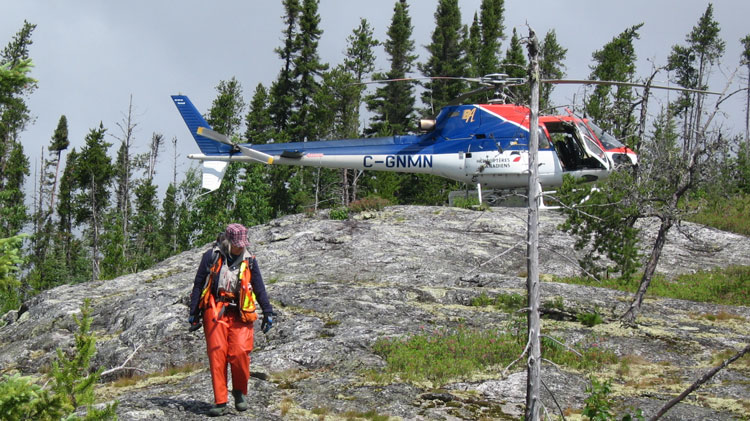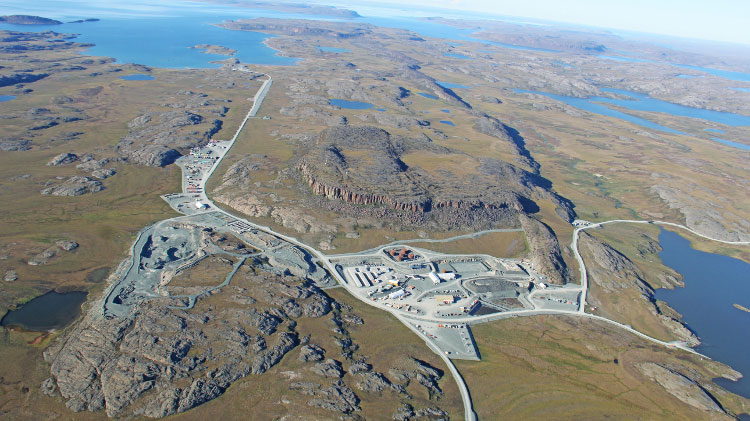All 90 injection and recovery wells planned for start-up at the Florence Copper mine have been drilled and constructed. Courtesy of Taseko Mines
Editors’ note: After this article was published in print in the September/October issue, Taseko Mines began wellfield operations at its Florence Copper project in October, marking the start of commercial production.
In the desert town of Florence, Arizona, Taseko Mines Limited is approaching a milestone—the start-up of the world’s first greenfield in-situ copper recovery (ISCR) mine. The Canadian company’s wholly owned Florence Copper project, located just over 100 kilometres southeast of Phoenix in Arizona’s historic copper corridor, is entering its final stretch before commercial production.
“Florence Copper is not a typical mining operation,” said Sean Magee, vice-president of corporate affairs at Taseko. “It employs ISCR, [which is] a low-impact copper extraction method that has long-term environmental and economic benefits.”
Taseko is currently constructing a commercial production facility at Florence Copper, with first copper production expected in the fourth quarter of this year. Once fully operational, Florence Copper’s annual production capacity will be 85 million pounds of London Metal Exchange (LME) Grade A copper cathode over a mine life of 22 years.
Unlike traditional open-pit or underground mines, the Florence Copper ISCR operation will leave the landscape largely undisturbed. Instead of moving large quantities of rock, the ISCR operation will inject a low-pH solution (called raffinate, and comprising 99.5 per cent water and 0.5 per cent sulfuric acid) through a series of injection wells into targeted portions of a bedrock layer—called the copper oxide zone—that occurs between approximately 400 to 1,200 feet (roughly 120 to 365 metres) below surface.
The raffinate will dissolve copper minerals into a pregnant leach solution (PLS), which will be pumped to the surface by recovery wells. The PLS will then be sent to Florence Copper’s solvent extraction and electrowinning (SX/EW) processing plant, where the dissolved copper will be removed from the solution and electricity will be used to plate the copper into 99.99 per cent pure copper cathode. The solution will be recycled back into the deposit and reused.
According to Richard Tremblay, chief operating officer at Taseko, the feasibility of applying ISCR mining methods depends on a deposit’s geology and hydrology. “For copper, some key factors include the mineralization type (oxide versus sulfide), rock fracturing, transmissivity and groundwater conditions,” he said.
The ore body at Florence Copper has all the conditions necessary to make ISCR feasible; it is naturally porous and shattered, as well as saturated with water, which means the extraction solution can easily flow through it. “While these conditions may be shown to exist in other locations, Florence Copper is currently the only proven and permitted greenfield ISCR operation in the world,” said Tremblay.
Development journey
In the 1970s, Continental Oil Company (Conoco) investigated the potential of developing a mine at the Florence Copper site, but concluded that its hydrogeological conditions made traditional open-pit or underground mining unfeasible.
Magma Copper acquired the project in 1992 and began detailed engineering on the development of an ISCR operation with an SX/EW plant. BHP acquired Magma in 1996 and continued the testwork, including commencing an ISCR pilot test. However, in 2000, BHP deferred operations at Florence Copper due to low metal prices. Curis Resources acquired the property in December 2009 and resumed project development, including engineering programs, environmental studies and community engagement in support of project permitting.
Taseko acquired the Florence Copper project in 2014 as part of its US$70 million acquisition of Curis; according to Taseko, Florence Copper’s former owners had spent over US$135 million on developing the project, and all major power, transportation, road and rail infrastructure was already in place.
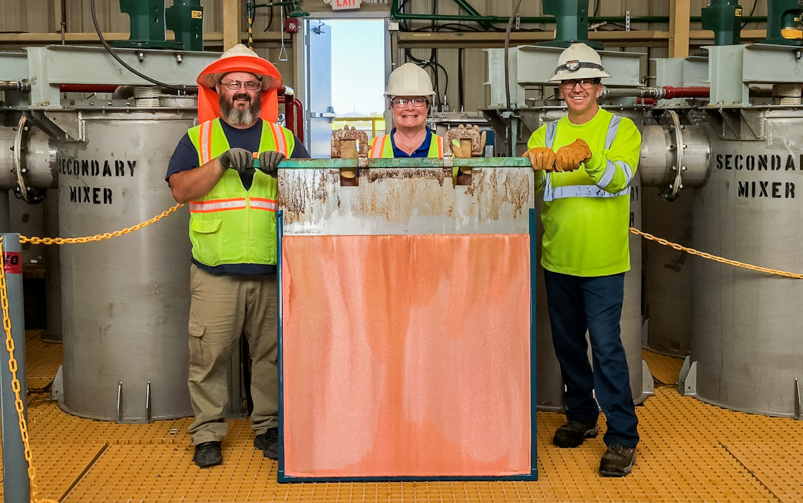 The first copper cathode harvest from Florence Copper’s production test facility in April 2019. Courtesy of Taseko Mines
The first copper cathode harvest from Florence Copper’s production test facility in April 2019. Courtesy of Taseko Mines
Since in-situ recovery has not been extensively used for copper extraction—it is most commonly used in uranium, potash or oil sands mining—Taseko built the Florence Copper project in two phases.
The first was a production test facility that Taseko constructed at site in 2018 and began operating under commercial leaching conditions in December of that year. It included a wellfield of 13 injection and recovery wells along with a small SX/EW plant and was designed to demonstrate the operational and environmental viability of the ISCR process.
In April 2019, the production test facility made its first harvest of 3,700 pounds of copper cathode, which was assayed by an independent laboratory at higher than 99.9 per cent copper. The production test facility ceased operations in June 2020, followed by a four-month leaching ramp-down period before transitioning into a rinsing phase. Over its 18 months of operation, the production test facility produced more than one million pounds of copper.
“This work significantly de-risked the project from a technical perspective and gave us the confidence to move forward with the commercial scale facility,” said Tremblay. “The production test facility provided the Florence Copper operations team with site-specific ISCR operating experience, which will be tremendously beneficial as we begin commissioning and advance to full commercial production.”
The second phase is the commercial production facility, currently under construction; Taseko acquired the final underground injection control permit for the Florence Copper project from the U.S. Environmental Protection Agency (EPA) in September 2023, and construction began in January 2024.
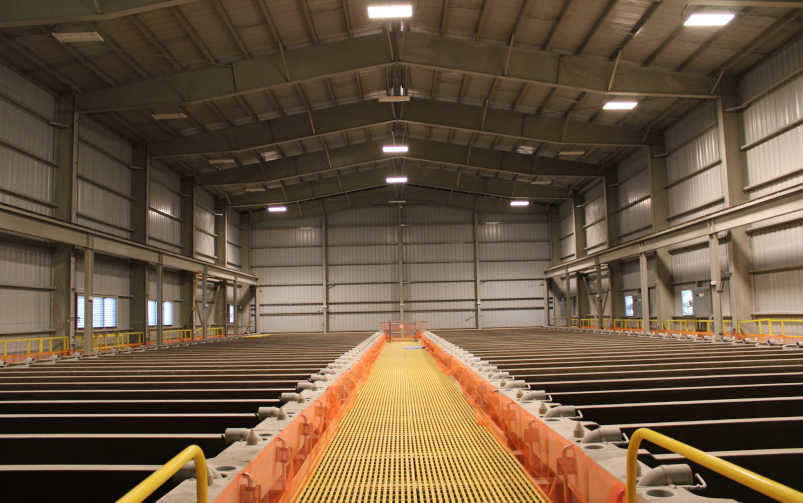 The installation of major components for Florence Copper’s solvent extraction and electrowinning plant is in progress. Courtesy of Taseko Mines
The installation of major components for Florence Copper’s solvent extraction and electrowinning plant is in progress. Courtesy of Taseko Mines
By the end of June this year, construction of the commercial production facility was over 90 per cent complete. All 90 injection and recovery wells planned for the construction phase have been drilled and completed, the site’s 69-kilovolt substation has been energized, and the installation of major components for the SX/EW areas is in progress.
Taseko stated in its financial and operational results for the second quarter of 2025 that approximately US$239.3 million in construction costs had been incurred over the previous 18 months. Rob Rotzinger, Taseko’s vice-president of capital projects, said the company continues to expect the final construction costs to be about 10 to 15 per cent higher than the previous 2023 estimate of US$232 million.
A low-cost, low-carbon advantage
According to Taseko, Florence Copper is one of the lowest capital intensity copper development projects in the world at under US$7,000 per tonne of annual production, compared to up to US$20,000 per tonne for other copper projects being developed in Arizona.
In addition, operating costs are forecast to be approximately US$1.11 per pound of copper, which is in the lowest quartile among global copper producers. “This cost advantage is due to the nature of the ISCR process, which avoids the high operating costs associated with conventional mining activities,” said Rotzinger.
The project’s environmental footprint is equally competitive. “At full commercial production, copper produced at Florence Copper is expected to have the lowest GHG [greenhouse gas] intensity per unit of production among primary copper producers in North America,” said Magee. “The operation does not require blasting, loading, hauling, dumping, crushing or conveying of mineralized material and waste; this contributes to 75 per cent fewer GHG emissions, 65 per cent less energy use and 78 per cent less water consumed per unit of production than conventional open-pit copper mines in Arizona.”
Producing the copper cathode on site will also contribute to the project’s lower GHG intensity. “This eliminates the need to ship copper concentrate to smelters and refineries overseas, resulting in lower costs, fewer emissions and less waste,” said Magee. He added that Florence Copper will “substantially” lower the company’s enterprise-wide GHG intensity.
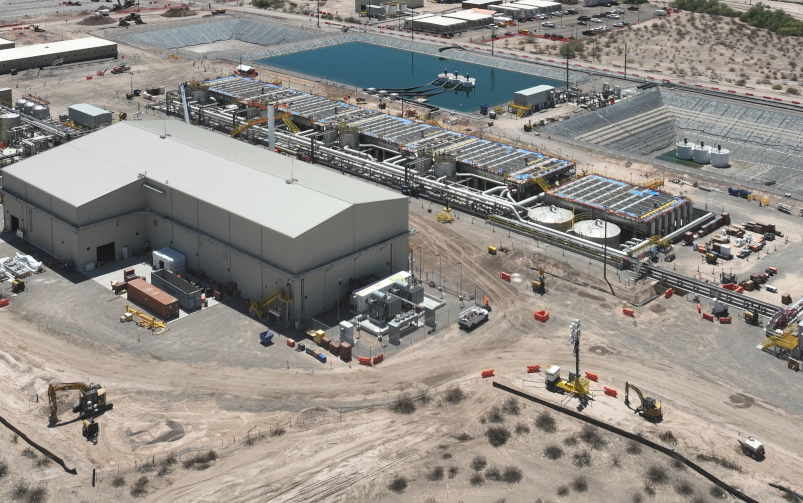 Construction of the commercial production facility at Florence Copper was over 90 per cent complete by the end of June. Courtesy of Taseko Mines
Construction of the commercial production facility at Florence Copper was over 90 per cent complete by the end of June. Courtesy of Taseko Mines
Protecting the integrity of regional groundwater sources is a critical requirement for successful ISCR operations, Magee said. “This is achieved at Florence Copper by maintaining hydraulic control of injected solutions at all times through carefully managed pumping rates [which creates an inward hydraulic gradient towards the wellfield that prevents solutions from moving out of the leaching area] and the deployment of a robust system of monitoring and compliance wells,” he said.
In addition to ideal conditions for hydraulic control of solutions, there are also geological barriers to solution migration at Florence Copper. There is a thick clay layer above the ore body that acts as an aquitard—a protective barrier—preventing solution from moving up into the upper aquifer. The oxide zone is also separated from deeper groundwater by a relatively impervious sulfide system. The injection and recovery wells used in the ISCR process are cased with a high-impact, corrosive-resistant pipe, and the annulus around the casing is fully sealed using type V cement from surface to 40 feet (about 12 metres) into the copper oxide zone—Florence Copper’s EPA permit requires that the wells extend this far into the bedrock to guarantee that the injected solutions remain entirely in the copper oxide zone.
In addition to evaporation of excess process water, Florence Copper has implemented a water conservation program on site. “Earlier this year, Florence Copper received authorization from the State of Arizona to utilize treated surplus process water that meets relevant water quality standards for agricultural use to supplement a local farmer’s annual irrigation needs,” said Magee.
“The Florence Copper site encompasses more than 1,300 acres, approximately 25 per cent of which is leased to a local farmer for alfalfa production. Surplus water provided to this farmer for irrigation purposes meets state water quality standards for irrigation and will supplement valuable regional water sources while contributing to local agricultural production.”
Taseko also integrated comprehensive reclamation planning into the earliest stages of the mine’s development. The Florence Copper reclamation plan includes wellfield closure, infrastructure removal and land surface restoration to ensure the site is returned to a safe, stable and productive condition following the completion of operations. “All production and recovery wells will be decommissioned and sealed in accordance with state and federal regulations,” said Magee. “Aquifer rinsing [will] return in-situ water qualities to pre-leaching conditions or values as specified in the permit [from the Arizona Department of Environmental Quality].”
Since ISCR minimizes surface disturbance and alterations, there will be no tailings pond or waste dumps to reclaim at the end of the mine’s life. “The site can be used for parks, housing, farming or other purposes that may be determined by future owners and governments,” said Magee.
An economic powerhouse
With the transition to commissioning in progress and first production just months away, Florence Copper is set to ramp up to its full 85-million-pound annual capacity. Future wellfield expansions will sustain production through the mine’s planned 22-year life, cementing its role as a key supplier of low-carbon copper for the domestic market. Magee said that at full commercial production, Florence Copper will be the third-largest copper cathode producer in the United States.
The project’s impact will extend well beyond its fences. Over its life of mine, Magee said that Florence Copper is expected to contribute US$4.3 billion to Arizona’s gross domestic product, generate US$2.2 billion in personal income for individuals and families, and provide more than US$593 million in state and local tax revenues—over half of that flowing directly to Pinal County and the town of Florence. At full operation, Taseko estimates the mine will support roughly 820 direct and spinoff jobs annually.
Magee noted that the operation’s location in Arizona offers several advantages. “With a strong and growing presence of electric vehicle and semiconductor manufacturers in the region, and solar power playing a major role in the state’s energy mix, Florence Copper is well positioned to serve key cleantech markets,” he said. “Local production and direct truck transport to end users will avoid the long-distance overseas shipping that many other copper producers rely on. Florence Copper will deliver a domestically produced, ready-to-use supply of copper metal directly to the American market.”
It is also a particularly good time to be bringing a new copper mine to production. According to the International Energy Agency’s 2025 global critical minerals outlook, the current copper mine project pipeline indicates that there could be a 30 per cent global supply shortfall by 2035. In the United States, COMEX copper prices reached a record high in July due to potential tariffs of up to 50 per cent on imported copper.
“Considering the current state of geopolitical and trade uncertainty, ensuring a secure supply of critical minerals in North America has never been more important,” said Magee. “Copper is essential to both Canada’s and the United States’ economic and manufacturing resilience, underpinning key sectors tied to defence, national security and the clean energy transition.”
